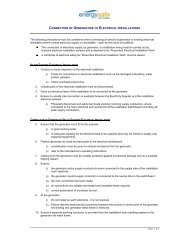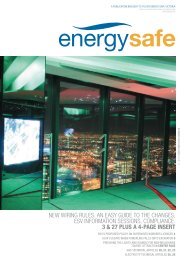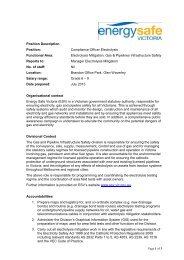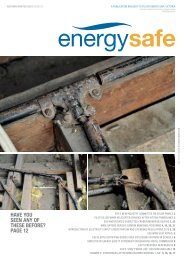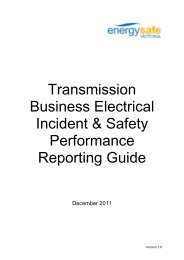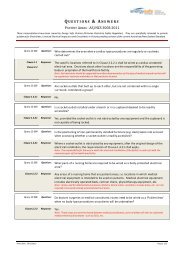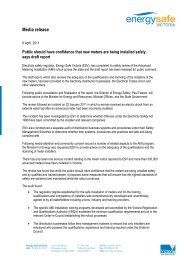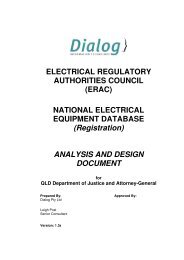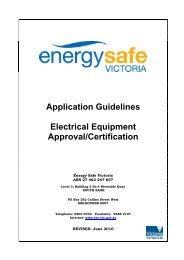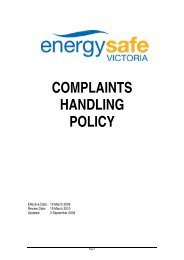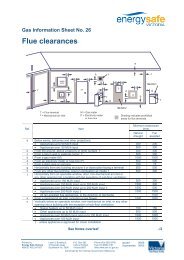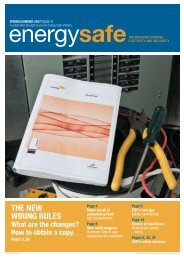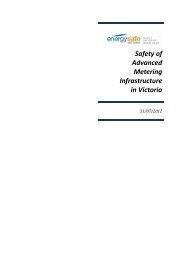Electrical Safety Rules for Vegetation Management Work Near
Electrical Safety Rules for Vegetation Management Work Near
Electrical Safety Rules for Vegetation Management Work Near
Create successful ePaper yourself
Turn your PDF publications into a flip-book with our unique Google optimized e-Paper software.
<strong>Electrical</strong> <strong>Safety</strong> <strong>Rules</strong><strong>for</strong><strong>Vegetation</strong> <strong>Management</strong><strong>Work</strong> <strong>Near</strong> OverheadPowerlines byNon-<strong>Electrical</strong> <strong>Work</strong>ersDate of Issue: 1 Sept 2013 ESV: <strong>Electrical</strong> InfrastructureVersion 1.0 Document # Trim ref Page 1 of 20Warning: The most up-to-date version is located on the ESV Website. Printed copies of thisdocument MAY NOT BE THE LATEST.
These electrical safety rules do not apply to vegetation management work: by a person who has not completed a training course approved by EnergySafe Victoria and is there<strong>for</strong>e required to comply with Division 2, Part 3 ofthe Electricity <strong>Safety</strong> (Installations) Regulations 2009; or by persons directly engaged by the electricity asset owner; or in the vicinity of electrical apparatus supported by a tower structure(transmission lines). Written permission from the owner of the towerstructure shall be obtained prior to carrying out such work.2 DEFINITIONThis section gives a list of words and terms and their definitions as used in thisdocument.Each defined word or term has its definition set alongside. When the definedword or term is shown in italics in the text of the document, it has the definedmeaning. Where a defined word or term is not printed in italics in the body of thetext, it must be interpreted as the context of the text indicates or requires.‘Access Authority’ means any <strong>for</strong>m of authorisation issued by an electricityasset owner, which allows access to, or work near, electrical apparatus.„Approved‟ means having appropriate organisation endorsement in writing <strong>for</strong> aspecific function.„Agreed process‟, <strong>for</strong> the purpose of Clauses 4.1 and 4.4, means a processapproved by both the other responsible person and the relevant electricity assetowner, taking into account the following safety principles: <strong>Safety</strong> must not be compromised; and Effective communication of requirements in clauses 4.1 and 4.4; and Compliance with other applicable safety laws and requirements.„Bare’ means, in relation to a conductor, not insulated.„Cable’ means an insulated conductor or two or more such conductors laidtogether, whether with or without fillings, rein<strong>for</strong>cements or protective coverings.‘Climber’ means a vegetation management worker who carries out vegetationmanagement work while the worker is supported by that vegetation.„Conductor‟ means a wire, or <strong>for</strong>m of metal designed <strong>for</strong> carrying electriccurrent.‘Competent’ means having the skills, knowledge and attributes a person needsto safely complete a task.Date of Issue: 1 Sept 2013 ESV: <strong>Electrical</strong> InfrastructureVersion 1.0 Document # Trim ref Page 3 of 20Warning: The most up-to-date version is located on the ESV Website. Printed copies of thisdocument MAY NOT BE THE LATEST.
‘Covered low voltage conductor’ means a low voltage conductor that iscovered <strong>for</strong> environmental, mechanical or visual purposes but is not consideredto be insulated.„De-energised’ means not connected to any source of electrical supply but notnecessarily isolated.‘Earthed’ means directly electrically connected to the general mass of earth, soas to ensure and maintain the effective dissipation of electrical energy.„<strong>Electrical</strong> apparatus’ means any electrical equipment, including overheadpowerlines and underground cables, the conductors of which are live or can bemade live.‘Electricity asset owner’ means the owner, controller or operator of an electricalapparatus or electricity supply network.„Elevating work plat<strong>for</strong>m or EWP’ means a vehicle on which a boom typemechanism, either articulating or telescoping, is installed. The mechanism isdesigned and used <strong>for</strong> the positioning of personnel at work sites or <strong>for</strong> positioningboth personnel and equipment at work sites.‘Energised’ means connected to a source of electrical supply.“ESV” means Energy Safe Victoria.„Exposed conductor’ means an electrical conductor, approach to which is notprevented by a barrier of rigid material or by insulation which is adequate under arelevant Australian Standard specification <strong>for</strong> the voltage concerned.„Ground worker’ means a vegetation management worker that carries outvegetation management work from the ground.„High voltage’ or ‘HV’ means a nominal voltage exceeding 1,000V AC orexceeding 1,500V DC.‘Insulated’ means separated from adjoining conducting material by a nonconductingsubstance which provides adequate resistance to the passage ofcurrent, or to disruptive discharges through or over the surface of the substanceat the operating voltage, and to mitigate the danger of shock or injurious leakageof current.„Insulated elevating work plat<strong>for</strong>m or insulated EWP‟ means an elevatingwork plat<strong>for</strong>m that complies with the design and electrical testing requirements ofAS 1418.10.„Insulated plant, tools and equipment’ means plant, tools and equipmentspecifically designed, approved, tested and maintained <strong>for</strong> use on or near liveelectrical apparatus. They shall be used only on or near electrical apparatus,Date of Issue: 1 Sept 2013 ESV: <strong>Electrical</strong> InfrastructureVersion 1.0 Document # Trim ref Page 4 of 20Warning: The most up-to-date version is located on the ESV Website. Printed copies of thisdocument MAY NOT BE THE LATEST.
which is energised at a voltage equal to or less than the voltage rating nominatedby the manufacturer of the plant, tool or equipment.„Isolated‟ means disconnected from all possible connection sources of electricitysupply by means which will prevent unintentional energisation of the apparatusand which is assessed as a suitable step in the process of making safe <strong>for</strong>access purposes.‘Live’ means energised or subject to hazardous induced or capacitive voltages.„Low voltage’ or ‘LV’ means nominal voltage exceeding 50V AC or 120V DC butnot exceeding 1000V AC or 1500V DC.„Mobile plant’ means cranes, elevating work plat<strong>for</strong>ms, tip trucks or similar plant,any equipment fitted with a jib or boom and any device capable of raising orlowering a load.„<strong>Near</strong>’ means a situation where there is a reasonable possibility of a person,mobile plant or equipment (other than approved insulated tools and equipment)either directly or through any conducting medium, coming within the relevant safeapproach distances.‘Non-conducting rope’ means standard commercial grade synthetic rope, madefrom a material, which is known to have electrical insulating properties, but is notelectrically tested.‘Other responsible person’ (ORP) means an entity responsible <strong>for</strong> the workrelated to vegetation management work under subsections 84(4) and 84(6) of theElectricity <strong>Safety</strong> Act 1998 (e.g. municipal councils).‘Overhead electric line’ means any aerial conductor or conductors withassociated supports, insulators and other apparatus erected, or in the course oferection, <strong>for</strong> the purpose of the conveyance of electrical energy. Note: For thepurposes of this document, “overhead electric line” does not include any pole orsimilar support when determining the safe approach distance from liveconductors.‘Powerline’ means an overhead electric line with a nominal Voltage of 66kV orless.‘Personal protective equipment’ means clothing, equipment and/orsubstances, which when worn or correctly used, protect parts or all of the bodyfrom <strong>for</strong>eseeable risk of injury or disease at work or in the workplace.„Procedure’ means the documentation of a systematic series of actions (oractivities) directed to achieve a desired result.„Safe’ means not posing an unacceptable risk to life, health or property.Date of Issue: 1 Sept 2013 ESV: <strong>Electrical</strong> InfrastructureVersion 1.0 Document # Trim ref Page 5 of 20Warning: The most up-to-date version is located on the ESV Website. Printed copies of thisdocument MAY NOT BE THE LATEST.
„Safe approach distance’ means the minimum distance in air from exposedconductors that shall be maintained by a person, vehicle or mobile plant(including its load, controlling ropes and any other accessories) whenapproaching electrical apparatus other than <strong>for</strong> work in accordance with anaccess authority.„<strong>Safety</strong> observer’ means a person with sufficient knowledge of the task beingper<strong>for</strong>med and competent <strong>for</strong> the duty of observing and warning of any unsafeapproach to electrical apparatus.‘Scheduled vegetation management work’ means vegetation managementwork programmed to be carried under an electric line clearance managementplan that has been prepared in accordance with the Electricity <strong>Safety</strong> (ElectricLine Clearance) Regulations.„Service provider’ is a person or an entity that is engaged by other responsibleperson to undertake vegetation management work.‘Shall’ – is to be interpreted as “mandatory”.‘Should’ – is to be interpreted as “advisory or discretionary”.„Tested’ – means tested in accordance with the relevant standards.‘Urgent vegetation management work’ means vegetation management work inresponding to an un<strong>for</strong>eseeable event which requires the pruning, cutting,trimming or felling of a specific vegetation, to avoid imminent danger to the publicor the electricity supply network.‘<strong>Vegetation</strong>‟ means any living or non-living flora or any part of that flora.‘<strong>Vegetation</strong> clearance’ means the minimum separation in air that shall bemaintained between vegetation and live electrical apparatus when per<strong>for</strong>mingvegetation management work.‘<strong>Vegetation</strong> management work’ means the pruning, cutting, trimming or fellingof, or application of herbicides to, vegetation and assisting to prune, cut, trim orfell, or apply herbicides to, vegetation, where: any part of the vegetation being pruned or cleared may come within 2metres of live overhead powerlines, orthe work requires any person, tool, equipment or vehicle to come closer tolive overhead powerlines than the following relevant minimum distances:a) 100 mm <strong>for</strong> insulated low voltage conductorsb) 1500 mm <strong>for</strong> bare or covered low voltage conductorsc) 2000 mm <strong>for</strong> high voltage conductor with a nominal voltage notexceeding 66kV.Date of Issue: 1 Sept 2013 ESV: <strong>Electrical</strong> InfrastructureVersion 1.0 Document # Trim ref Page 6 of 20Warning: The most up-to-date version is located on the ESV Website. Printed copies of thisdocument MAY NOT BE THE LATEST.
„<strong>Vegetation</strong> management worker’ means a person:whose qualifications, experience and training and assessment ensurecompetency in the per<strong>for</strong>mance of vegetation management work; andwho has completed a training course approved by ESV; andwho has technical knowledge or sufficient experience to per<strong>for</strong>m the dutyconcerned; andwho has been endorsed in writing by an organisation (e.g. the employer)to per<strong>for</strong>m the work.‘Vicinity’ means a situation where it is unlikely that a person will, either directlyor through any conducting medium (e.g. via mobile plant), come within therelevant safe approach distances.‘Voltage’ means a difference of electrical potential normally existing betweenconductors or between conductors and earth.3 GENERAL PRINCIPLESThese electrical safety rules should be applied in the context of the followingprerequisites:(a)(b)(c)(d)(e)(f)Other responsible persons and service providers have in place aneffective risk management process, as part of a systematic approachto managing safety, including the necessary organisational structures,accountabilities, policies and procedures.Appropriate workplace hazard and risk assessments are carried outprior to the commencement of work.The safe approach distances used are appropriate <strong>for</strong> the class ofperson and work to be per<strong>for</strong>med.The safe approach distances in these electrical safety rules are basedon an “exclusion zone” principle. This principle defines an area nearthe electrical apparatus into which no part of the person, mobile plant,tools and equipment may encroach taking into account the possibilityof inadvertent movement of the person or plat<strong>for</strong>m.An effective process is in place to monitor and audit the complianceagainst these rules and documented safe work procedures <strong>for</strong>vegetation management work.When pruning vegetation near live overhead powerlines, arboriculturetechniques should be used where practicable, in accordance with theappropriate Australian Standard.Date of Issue: 1 Sept 2013 ESV: <strong>Electrical</strong> InfrastructureVersion 1.0 Document # Trim ref Page 7 of 20Warning: The most up-to-date version is located on the ESV Website. Printed copies of thisdocument MAY NOT BE THE LATEST.
4. NOTIFICATION OF WORK4.1 Scheduled <strong>Vegetation</strong> <strong>Management</strong> <strong>Work</strong> near Low Voltage OverheadConductorsFor the purpose of notification of scheduled vegetation management work nearlow voltage overhead conductors, an agreed process between the otherresponsible person and the relevant electricity asset owner can be established tocomply with regulation 319(2) of the Electricity <strong>Safety</strong> (Installations) Regulations2009.4.2 Scheduled <strong>Vegetation</strong> <strong>Management</strong> <strong>Work</strong> near High Voltage OverheadConductorsFor scheduled vegetation management work near high voltage overheadconductors, a notification shall be lodged with the electricity asset owner in the<strong>for</strong>m required by the electricity asset owner at least 10 business days prior to theproposed date of work. Further discussion with the electricity asset owner maybe required and may result in variation to scheduled work including times.4.3 Submission of NotificationBe<strong>for</strong>e making a notification, the other responsible person or their engagedservice providers shall establish that the proposed work has been properlyplanned and can be carried out safely and shall consider: work method to be utilised; and type of electricity assets, and equipment required; and work environment; and current competence of the work party.On making a notification the following in<strong>for</strong>mation should be given: the electrical assets and location shall be accurately defined. Appropriatediagrams and/or maps shall be used to show the work area in relation toelectrical assets; and the work method and mobile plant to be used; and the intended or proposed date and times of the works; and contact details of the person on site on the day of the works.Date of Issue: 1 Sept 2013 ESV: <strong>Electrical</strong> InfrastructureVersion 1.0 Document # Trim ref Page 8 of 20Warning: The most up-to-date version is located on the ESV Website. Printed copies of thisdocument MAY NOT BE THE LATEST.
This in<strong>for</strong>mation should be used to determine the circuits involved and the abilityto apply the applicable network protection or configuration required.The electricity asset owner shall respond to the notification at least 3 businessdays prior to the commencement date of the work specified in the submittednotification.<strong>Work</strong> may not proceed until confirmation has been received from the electricityasset owner.Contact in<strong>for</strong>mation of electricity asset owners are as below:Company Phone emailCitipower or (03) 5338 3300Powercor(Vemco)Jemenaorp.notification@jemena.com.auSP AusNet (03) 9237 4408United Energy (03) 8846 9900If contact in<strong>for</strong>mation changes it shall be the responsibility of the electricity assetowner to notify other responsible persons and ESV revised contact in<strong>for</strong>mation atthe earliest opportunity.4.4 Urgent <strong>Vegetation</strong> <strong>Management</strong> <strong>Work</strong> near High Voltage OverheadConductorsNotification <strong>for</strong> urgent vegetation management works shall be undertaken inaccordance with the agreed process or procedure established between the otherresponsible person and the electricity asset owner.Date of Issue: 1 Sept 2013 ESV: <strong>Electrical</strong> InfrastructureVersion 1.0 Document # Trim ref Page 9 of 20Warning: The most up-to-date version is located on the ESV Website. Printed copies of thisdocument MAY NOT BE THE LATEST.
5. GENERAL SAFETY REQUIREMENTSNo vegetation management work shall be per<strong>for</strong>med if other work couldcompromise the safety of the vegetation management work team.Extreme care shall be taken when using uninsulated tools, equipment or plant inthe vicinity of electric lines, with particular attention to ensure the clearanceslisted in Tables 1 & 2 are not encroached.If vegetation management work causes any damage or outage to a network theORP shall advise ESV and the electricity asset owner through an incidentreporting process.5.1. Hazard identification and risk assessmentPrior to commencing <strong>Vegetation</strong> management work near live overhead powerlines, a documented hazard identification and risk management process shall beundertaken to identify and address hazards associated with the work to becompleted, work site conditions, environmental conditions, the use of materials,mobile plant, tools and equipment. Such a process shall:(a)(b)(c)(d)Identify the hazard; andAssess the risk; andDetermine control measures; andMonitor and review the effectiveness of the control measures duringthe work activity.5. 1. 1. HazardsHazards that may be encountered include but are not limited to:(a)(b)(c)(d)Unexpected movement of the worker, mobile plant or the vegetationrelative to the electrical apparatus.Unexpected lateral movement (sway) of the conductors due to wind,particularly in gusty conditions.Unexpected drop in height (sag) of the conductors due to temperaturerise associated with changes in electrical load, solar radiation orreduced cooling under light or still wind.Supply network fault conditions may create extreme movement ofconductors and poles.Date of Issue: 1 Sept 2013 ESV: <strong>Electrical</strong> InfrastructureVersion 1.0 Document # Trim ref Page 10 of 20Warning: The most up-to-date version is located on the ESV Website. Printed copies of thisdocument MAY NOT BE THE LATEST.
(e)(f)(g)(h)The integrity of the adjacent structures, conductor and of anyinsulation on live conductors.Site conditions (stability of equipment and footing), vehicular traffic,pedestrians, or livestock management (interference with the work).Direct or indirect contact with live overhead powerlines via vegetationor tools and equipment.Hazardous voltages that may be present in all parts of the work areaincluding the base of vegetation where any part of the vegetation is incontact with live overhead powerlines, particularly during wet and/orwindy conditions.5.1.2 Controlling hazardous situationsA hierarchy of control shall be used when considering appropriate hazard controlmeasures. These measures shall include the use of appropriately trainedpersons to control risks from hazardous situations in accordance with writtenprocedures approved by other responsible persons or Service providers. Thismay be achieved by but is not limited to one or more of the following methods:(a)(b)(c)(d)(e)(f)(g)Making applications to the electricity asset owner to have the electricalapparatus isolated and earthed (made safe)The use of approved live work procedures (e.g. insulated mobile plant,tools and equipment)Provision of a suitably trained safety observerIncreasing the minimum safe approach distances required to safelycarry out the <strong>Vegetation</strong> management work including allowance <strong>for</strong>unexpected conductor movementThe use of suitable personal protective equipmentDefining and establishing drop zonesThe suppression of auto-reclose functionality on electrical protectionequipmentWhen per<strong>for</strong>ming vegetation management work, vegetation managementworkers shall control tools and equipment in such a manner as to maintain theappropriate safe approach distances at all times.Only synthetic ropes shall be used <strong>for</strong> vegetation work. Synthetic rope isconsidered to be non-conducting, but is not electrically tested and has noguaranteed insulating properties. Non-conducting rope shall be kept away fromlive components, by a distance at least equal to the applicable safe approachdistances in Tables 1&2.Date of Issue: 1 Sept 2013 ESV: <strong>Electrical</strong> InfrastructureVersion 1.0 Document # Trim ref Page 11 of 20Warning: The most up-to-date version is located on the ESV Website. Printed copies of thisdocument MAY NOT BE THE LATEST.
All ropes should be kept clean and clear of deteriorating contaminants such ashand creams, sunscreens, paint solvents, hydraulic oil, fuels, etc. which mayaffect or cause deterioration of the insulating qualities of equipment.Contaminated ropes should be discarded.5.1.3 Insulated tools and equipmentAll insulated tools and insulated equipment used <strong>for</strong> the purpose of vegetationmanagement work shall be electrically tested at intervals not exceeding sixmonths. The appropriate electrical insulation test shall be carried out inaccordance with the manufacture specifications or other appropriate industrystandard.All insulated tools and equipment should be maintained in a clean and drycondition.Insulated tools and equipment should not be laid directly on the ground.Insulated tools and equipment shall be stored and transported in a way that shallensure the equipment is not exposed to excess moisture, dust, abrasion andother deteriorating effects.Insulated tools and equipment shall be visually inspected and cleaned be<strong>for</strong>euse.Any tool that appears to be defective shall be labelled defective, and quarantinedfrom service <strong>for</strong> further inspection, testing, repair or replacement.All insulating tools and equipment should be kept clear of deterioratingcontaminants such as hand creams, sunscreens, paint solvents, hydraulic oil,fuels, etc. which may affect or cause deterioration of the insulating qualities ofequipment.5.1.4 Weather conditions<strong>Vegetation</strong> management work near live overhead powerlines shall not proceed inthe event of the following conditions:(a)an electrical storm is observed in the vicinity of the worksite; orDate of Issue: 1 Sept 2013 ESV: <strong>Electrical</strong> InfrastructureVersion 1.0 Document # Trim ref Page 12 of 20Warning: The most up-to-date version is located on the ESV Website. Printed copies of thisdocument MAY NOT BE THE LATEST.
(b)(c)(d)excessive wind velocities such that work cannot be carried out safelydue to the potential <strong>for</strong> unexpected movement of conductors, plant orvegetation sufficient to breach safe approach distances; orwet working condition which may reduce the level of insulation of toolsand equipment; orvisibility is not adequate.5.2. Personal protective equipmentAll persons who undertake <strong>Vegetation</strong> management work near overheadpowerlines shall use approved personal protective equipment.Personal protective equipment shall include clothing with wrist to ankle cover andfully enclosed footwear. Additional personal protective equipment should be usedin accordance with the type of work and the risks involved.The following minimum personal protective equipment shall be worn and shallcomply with the relevant Australian Standards:(a)(b)(c)(d)(e)(f)(g)clothing: natural fibre or alternative arc flash protective materials;safety helmet;protective safety footwear with non-slip soles;safety eye protection;hearing protection, as required by the nature of the work beingper<strong>for</strong>med;working gloves as required by the nature of the task being per<strong>for</strong>med;fall protection/prevention equipment <strong>for</strong> working at height.5.3 Wearing of metallic objects (personal jewellery)Metallic objects such as neck chains, earrings and other body adornments, rings,watches and bracelets shall be removed or covered while carrying out <strong>Vegetation</strong>management work near live overhead powerlines. In the event of an arc flash,metallic objects may increase the level of injury sustained by the person.5.4 Long hairLong hair, including facial hair should be securely fixed and confined close to thehead.Date of Issue: 1 Sept 2013 ESV: <strong>Electrical</strong> InfrastructureVersion 1.0 Document # Trim ref Page 13 of 20Warning: The most up-to-date version is located on the ESV Website. Printed copies of thisdocument MAY NOT BE THE LATEST.
5.5. Appointment of a safety observerA safety observer(s) shall be appointed where any part of a person, mobile plantor vegetation could come within the safe approach distances. Depending on theposition and complexity of the work, more than one safety observer may berequired, however at least one safety observer must be positioned at groundlevel.The safety observer(s) shall not per<strong>for</strong>m any other task while acting as a safetyobserver and shall:(a)(b)(c)(d)(e)(f)(g)(h)(i)(j)be specifically instructed in the workplace hazards applicable; andensure that all persons, tools, plant and equipment remain outside thespecified minimum safe approach distance unless per<strong>for</strong>ming a rescuein accordance with approved procedures; andbe positioned at a suitable location to effectively observe the workbeing per<strong>for</strong>med; andnot observe more than one vegetation management work activity atany time; andhave the authority to suspend the activity at any time; andmaintain effective and immediate communication with the work teamat all times; andnot pass tools directly to the person per<strong>for</strong>ming the work; andsuspend all work in the event of having to leave the site or significantlychange position until he/she has returned/reached new location or hasbeen replaced; andbe trained and assessed competent to per<strong>for</strong>m rescue relevant to thework being undertaken and any plant being operated, andnot be subjected to distractions by other persons at the site.The safety observer‟s role may be rotated between members of the work team,<strong>for</strong> example to reduce fatigue. When this occurs it shall be sufficientlycommunicated so that all members of the work party are aware at all times whois per<strong>for</strong>ming the role of the safety observer(s).5.6 Mobile plantOnly insulated mobile plant (insulated elevating work plat<strong>for</strong>ms) shall be usedwhen working in accordance with this document.Date of Issue: 1 Sept 2013 ESV: <strong>Electrical</strong> InfrastructureVersion 1.0 Document # Trim ref Page 14 of 20Warning: The most up-to-date version is located on the ESV Website. Printed copies of thisdocument MAY NOT BE THE LATEST.
Uninsulated mobile plant (uninsulated elevating work plat<strong>for</strong>ms) must complywith No Go Zone <strong>Rules</strong>. No Go Zone rules are available at:ESV http://www.esv.vic.gov.au/For-Consumers/No-Go-Zones<strong>Work</strong>safe http://www.worksafe.vic.gov.au/safety-and-preventionMobile plant shall only be used in the vicinity of live conductors and/or electricalapparatus after precautions appropriate to the particular circumstances havebeen considered and action taken to control the associated hazards and risks.The control measures to be considered within a risk assessment should include: positioning the mobile plant such that it minimises the potential <strong>for</strong>encroaching into the safe approach distances area; and the use of safety observers; and the use of other precautions such as physical restrictions, on-site markerssetting boundary of plant operating area or control devices in conjunctionwith barriers.Other precautions related to the condition of the electrical apparatus shall bediscussed and agreed with the electricity asset owner.Mobile plant, and where appropriate, vehicles, shall be fitted with an approvedearthing device that will protect against the hazards presented by inducedvoltages or accidental contact with Live apparatus. This may be:an earth chain not less than 13mm diameter and allowing <strong>for</strong> 1 metrelength on the ground when the vehicle is raised off the ground; ora temporary driven earth stake that is bonded to the chassis of the vehicle.When mobile plant is operated from outside the mobile plant, precautions shallbe taken to protect the operator from hazardous step and touch potentials.No person other than the mobile plant operator shall touch the mobile plant whilein operation near live electrical apparatus unless it is necessary <strong>for</strong> the purposeof an emergency situation (refer section 7).During operation of the mobile plant near live conductors and/or electricalapparatus, only those persons at ground level actually involved in the workassociated with the mobile plant may be near the plant; all other persons shouldstay at least 6 metres away from the mobile plant.A person on the ground shall be provided to enable the rescue of the person/sworking aloft. This person needs to:Date of Issue: 1 Sept 2013 ESV: <strong>Electrical</strong> InfrastructureVersion 1.0 Document # Trim ref Page 15 of 20Warning: The most up-to-date version is located on the ESV Website. Printed copies of thisdocument MAY NOT BE THE LATEST.
understand how to lower the mobile plant in an emergency situation wherethe operator becomes incapacitated; andunderstand the risks and hazards that may be applicable following anincident.Training of operators of mobile plant shall include description of the hazards ofmovement of mobile plant in proximity to live electrical apparatus and detailprecautionary measures which may be taken to ensure safe working conditions.Inspection of the insulated sections of the mobile plant shall occur on a dailybasis, be<strong>for</strong>e use.5.7 Mobile Plant – TestingInsulated mobile plant used <strong>for</strong> access to vegetation near powerlines shall have acurrent electrical test certificate.Each EWP used in the vicinity of electrical apparatus shall be subjected to anapproved HV electrical test on its insulated section/s at intervals not exceedingsix months or more frequently depending on usage and work environment.The mobile plant shall not be accepted as suitable <strong>for</strong> use in the vicinity of liveelectrical apparatus unless it is within test date. (Refer to AS/NZS1418:10)Mobile plant should also have weight tests carried out in accordance with therelevant Australian Standards and the manufacturer‟s or industry requirements.6 VEGETATION MANAGEMENT WORKTree limbs shall be considered as conductive objects when within the safeapproach distances of HV conductors.Be<strong>for</strong>e undertaking vegetation management work, a risk assessment shall beconducted to assist in the identification and control of hazards to ensure that thework can be per<strong>for</strong>med safely.Issues to be considered prior to commencing work: tree climbing techniques shall only be used when other approvedmechanical methods <strong>for</strong> accessing trees are impracticable.Date of Issue: 1 Sept 2013 ESV: <strong>Electrical</strong> InfrastructureVersion 1.0 Document # Trim ref Page 16 of 20Warning: The most up-to-date version is located on the ESV Website. Printed copies of thisdocument MAY NOT BE THE LATEST.
positioning the mobile plant such that the safe approach distance can bemaintained in all circumstances; andthe use of safety observers; andconsideration of weather and environmental conditions (e.g. rain, wind,light, sag or sway of conductors); andmovement of the tree when cut.When per<strong>for</strong>ming vegetation management work, vegetation managementworkers shall observe appropriate safe approach distances outlined in tables 1and 2 below. Means of controlling the movement of limbs being cut should beassessed and action taken as appropriate.<strong>Vegetation</strong> overhanging LV conductors can be cut with the conductors liveprovided the movement of limbs being cut can be controlled. (Refer to Note1 intables 1 and 2)<strong>Vegetation</strong> overhanging and/or contacting HV conductors shall only be cut bypersons who are specifically trained and authorised <strong>for</strong> such work in accordancewith the electricity asset owner’s requirements.7 EMERGENCY SITUATIONSOther responsible persons and Service providers shall have in place documentedprocedures <strong>for</strong> response to electrical emergency situations.In emergency situations where there is a likely risk of an electric shock and burnsto persons from electrical conductors or electrical apparatus, e.g. fallenconductor, prompt action shall be taken to ensure people are kept well clear ofthe hazard. For fallen or exposed electrical conductors a safety clearance of 6metres shall apply.Where plant and equipment and conductive objects/trees are in contact, or withinsafe approach distances of electrical apparatus no attempt should be made to:(1) per<strong>for</strong>m a rescue of an injured person(s); or(2) approach electrical apparatus or electrically conductive objects,until an authorised representative from the electricity asset owner has confirmedas a minimum that the conductors are de energised with the preference beingthat the conductors are isolated and earthed (i.e. ‟made safe‟). The actions to betaken should take into account external factors (response time, event location,level of emergency and available in<strong>for</strong>mation).Date of Issue: 1 Sept 2013 ESV: <strong>Electrical</strong> InfrastructureVersion 1.0 Document # Trim ref Page 17 of 20Warning: The most up-to-date version is located on the ESV Website. Printed copies of thisdocument MAY NOT BE THE LATEST.
Where practicable: a worker is to remain on site to issue verbal warnings to any personmaking unsafe approach to fallen or exposed electrical conductors or access to the site must be controlled by the use of barriers or signs, e.g.rope, ribbon, portable flashing lamps, or traffic control devices i.e. witcheshats/bollards.Date of Issue: 1 Sept 2013 ESV: <strong>Electrical</strong> InfrastructureVersion 1.0 Document # Trim ref Page 18 of 20Warning: The most up-to-date version is located on the ESV Website. Printed copies of thisdocument MAY NOT BE THE LATEST.
Table 1: Safe Approach Distances (mm) <strong>for</strong> <strong>Vegetation</strong> <strong>Management</strong> <strong>Work</strong> <strong>Near</strong> OH lines when working from an insulated EWPInsulatedGreater than 22kV up to and includingBare or covered LVHV up to and including 22kVLV66kVAlldirectionsUnderconductorBesideconductorOverconductorUnderconductorBesideconductorOverconductorUnderconductorBesideconductorOverconductor<strong>Work</strong>er's BodyClearanceUninsulatedtool/EquipmentInsulated tool &EquipmentUninsulated Partof EWPInsulated Partof EWP<strong>Vegetation</strong>ClearancesNOTE:No Contact 300 300 300 1000 1000200 300 300 300 1000 1000200 300 300 300 1000 1000200 1000 1000 1000 2000 2000No Contact No Contact No Contact No Contact 1000 1000No clearancerequired 4Noclearancerequired 4Noclearance 1000 1 300 700required 4<strong>Work</strong> notpermitted2000 2000<strong>Work</strong> notpermitted 2000 2000<strong>Work</strong> notpermitted 2000 2000<strong>Work</strong> notpermitted 3000 3000<strong>Work</strong> notpermitted 2000 2000<strong>Work</strong> notpermitted 400 900<strong>Work</strong> notpermitted<strong>Work</strong> notpermitted<strong>Work</strong> notpermitted<strong>Work</strong> notpermitted<strong>Work</strong> notpermitted<strong>Work</strong> notpermitted1. <strong>Vegetation</strong> which is located at least 1000mm above bare LV conductor can be cleared subject to the following conditions: (a) A risk assessment is carried out with appropriatecontrol measure put in place and; (b) Effective control measures are used to prevent the cut vegetation from contacting the conductor or encroaching into the vegetation clearancespace. (c) a safety observer is posted.2. Conductor sag and sway exclusion: The safe approach distances and vegetation clearances detailed in the <strong>Electrical</strong> <strong>Safety</strong> <strong>Rules</strong> make no provision <strong>for</strong> conductor movement dueto wind or change in conductor temperature. Unexpected conductor movement may occur under moderate wind, network faults or changes in conductor heating or cooling factors.Conductor movement of several metres may result in long span/s of electric lines. Appropriate allowance <strong>for</strong> sway and sag changes must be applied in accordance with advicesought from the electrical asset owner.3. Where the safe approach distances cannot be maintained, an access authority must be obtained from the owner of the electrical asset.4. <strong>Vegetation</strong> contacting live LV conductors may be cut only after a risk assessment has been per<strong>for</strong>med and precautionary actions are taken to control hazards to ensure that thework can be per<strong>for</strong>med safelyDate of Issue: 1 Sept 2013 ESV: <strong>Electrical</strong> InfrastructureVersion 1.0 Document # Trim ref Page 19 of 20Warning: The most up-to-date version is located on the ESV Website. Printed copies of this document MAY NOT BE THE LATEST.
Table 2: Safe Approach Distances (mm) <strong>for</strong> <strong>Vegetation</strong> <strong>Management</strong> <strong>Work</strong> by Ground <strong>Work</strong>er and Climber working near OverheadPowerlines<strong>Work</strong>er's BodyClearanceUninsulatedtool/EquipmentInsulated tool &Equipment<strong>Vegetation</strong>ClearancesInsulatedLVAlldirectionsUnderconductorBare or covered LVBesideconductor200 1000 1000200 1000 1000200 300 300No clearancerequired 4No clearancerequired 4Overconductor<strong>Work</strong> notpermitted<strong>Work</strong> notpermitted<strong>Work</strong> notpermittedUnderconductorHV up to and including 22kVBesideconductor1200 12001000 10001000 1000No clearancerequired 4 3000 1 700 700Overconductor<strong>Work</strong> notpermittedGreater than 22kV up to and including66kVUnder Beside Overconductor conductor conductor2000 2000<strong>Work</strong> notpermitted 2000 2000<strong>Work</strong> notpermitted 2000 2000<strong>Work</strong> notpermitted900 900<strong>Work</strong> notpermitted<strong>Work</strong> notpermitted<strong>Work</strong> notpermitted<strong>Work</strong> notpermittedNOTE1. <strong>Vegetation</strong> which is located at least 3000mm above bare LV conductor, can be cleared subject to the following conditions: (a) A risk assessment is carried out with appropriatecontrol measure put in place and; (b) Effective control measures are used to prevent the cut vegetation from contacting the conductor or encroaching into the vegetation clearancespace (c) a safety observer is posted.2. Conductor sag and sway exclusion: The safe approach distances and vegetation clearances detailed in the <strong>Electrical</strong> <strong>Safety</strong> <strong>Rules</strong> make no provision <strong>for</strong> conductor movement dueto wind or change in conductor temperature. Unexpected conductor movement may occur under moderate wind, network faults or changes in conductor heating or cooling factors.Conductor movement of several metres may result in long span/s of electric lines. Appropriate allowance <strong>for</strong> sway and sag changes must be applied in accordance with advicesought from the electrical asset owner.3. Where the safe approach distances cannot be maintained, an access authority must be obtained from the owner of the electrical asset.4. <strong>Vegetation</strong> contacting live LV conductors may be cut only after a risk assessment has been per<strong>for</strong>med and precautionary actions are taken to control hazards to ensure that thework can be per<strong>for</strong>med safelyDate of Issue: 1 Sept 2013 ESV: <strong>Electrical</strong> InfrastructureVersion 1.0 Document # Trim ref Page 20 of 20Warning: The most up-to-date version is located on the ESV Website. Printed copies of this document MAY NOT BE THE LATEST.



